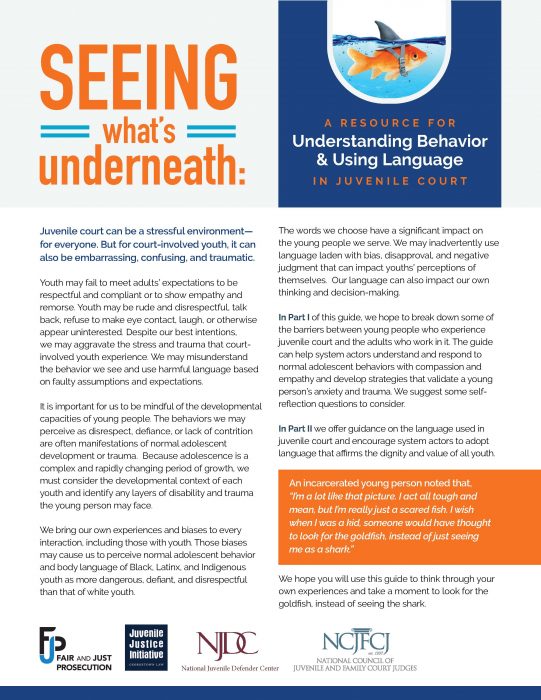Juvenile court can be a stressful environment— for everyone. But for court-involved youth, it can also be embarrassing, confusing, and traumatic. Youth may fail to meet adults’ expectations to be respectful and compliant or to show empathy and remorse.
Youth may be rude and disrespectful, talk back, refuse to make eye contact, laugh, or otherwise appear uninterested. Despite our best intentions, we may aggravate the stress and trauma that court-involved youth experience. We may misunderstand the behavior we see and use harmful language based on faulty assumptions and expectations.
It is important for us to be mindful of the developmental capacities of young people. The behaviors we may perceive as disrespect, defiance, or lack of contrition are often manifestations of normal adolescent development or trauma. Because adolescence is a complex and rapidly changing period of growth, we must consider the developmental context of each youth and identify any layers of disability and trauma the young person may face.
We bring our own experiences and biases to every interaction, including those with youth. Those biases may cause us to perceive normal adolescent behavior and body language of Black, Latinx, and Indigenous youth as more dangerous, defiant, and disrespectful than that of white youth. The words we choose have a significant impact on the young people we serve. We may inadvertently use language laden with bias, disapproval, and negative judgment that can impact youths’ perceptions of themselves. Our language can also impact our own thinking and decision-making.
In Part I of this guide, we hope to break down some of the barriers between young people who experience juvenile court and the adults who work in it. The guide can help system actors understand and respond to normal adolescent behaviors with compassion and empathy and develop strategies that validate a young person’s anxiety and trauma. We suggest some self reflection questions to consider.
In Part II we offer guidance on the language used in juvenile court and encourage system actors to adopt language that affirms the dignity and value of all youth.
Seeing What’s Underneath: A Resource for Understanding Behavior and Using Language in Juvenile Court is a collaborative effort by the National Juvenile Defender Center (NJDC), the National Council of Juvenile and Family Court Judges (NCJFCJ), Fair and Just Prosecution (FJP), and the Georgetown Law Juvenile Justice Initiative.
Click to access this publication in PDF format. Originally published 4/27/2021.

